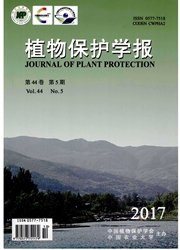

 中文摘要:
中文摘要:
为明确福建省致病疫霉的群体结构及其变化特点,对2001-2007年分离自11个市(县)的番茄和马铃薯产区的致病疫霉菌株进行交配型、甲霜灵敏感性及生理小种测定。交配型测定的187个菌株中,181株为A1交配型,1株为A2交配型,1株为A1,A2交配型,1株为自育交配型,其余3株交配型未知。对187个菌株的甲霜灵敏感性测定结果表明,高抗、中抗和敏感菌株分别占97.3%、2.1%、0.5%。生理小种测定结果表明,供试的11个抗性基因均可被克服,其毒性频率在3.3%-100%之间,51个菌株存在30个生理小种,其中小种3.7出现频率最高,为13.7%,是福建省优势生理小种类型;其次为小种3.4.7,发生频率为9.8%。
 英文摘要:
英文摘要:
In order to characterize population structure and its variation of Phytophthora infestans, the characteristics of mating type, metalaxyl sensitivity and physiological races of Phytophthora infestans isolates collected from tomato and potato in 11 different counties of Fujian Province during 2001 - 2007 were tested. Among 187 isolates tested, 181 isolates belonged to A1 mating type, 1 was A2 mating type, 1 was A1, A2 mating type, 1 was selffertil mating type, 3 isolates were unknown mating type. Among 187 isolates tested, the ratios of resistant, moderately resistant and sensitive isolates were 97.3 % , 2.1% and 0.5%. Physiological races of 51 isolates of Phytophthora infestans were identified. The results showed all known eleven resistance genes, with different frequency from 3.3% to 100% , could be overcame. Thirty different physiological races were detected in the 51 isolates, and race 3.7 was the dominant race in Fujian population with the frequency of 13.7%. followed by 3.4.7 with frequency of 9.8%.
 同期刊论文项目
同期刊论文项目
 同项目期刊论文
同项目期刊论文
 期刊信息
期刊信息
